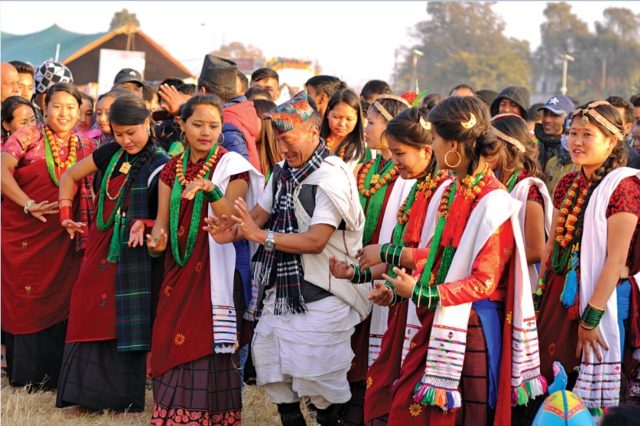GURUNG (TAMU)
Today I feel exceptionally pleased and glad to write
something about my own locale called Gurung (Tamu). As I was born in a Gurung
family and was raised in rehearsing the way of life and convention of the Gurung
community. So it would be a great honor and privilege for me to portray my
companions to know something about the Culture, Tradition, and History of Gurung
(Tamu) Community. So let us not sit around however experience the words
underneath which portray the Gurung Community in an excellent manner.
 |
| Gurung (Tamu) |
The text of their traditional religion is known as the
Pye-ta Lhu-ta contains the oral accounts of their traditional history. According to their history, the Gurung was a nomadic nation traveling westward
through Tibet before the entry of Mustang. Their Tibetan Sojourn pre-dates the
introduction of Buddhism there in the 7th century as the Gurung religious
traditions are basically animistic. They celebrated their feasts and festival
and performed ceremonies and rituals related to worship, birth, death, and marriage
depending on the religion of Bon and Buddhism. Gurung Dharma Priesthood
practitioners include Ghyabri (Ghyabring) and Pachyu (Paju). Shamanistic
elements among the Gurung’s remain strong and most Gurung’s often embrace
Buddhist and Bön rituals in communal activities. Gurung later came to adopt
Tibetan Buddhism. Some Gurung of eastern Nepal and the northeast hilly region of
India have also been influenced by the Hindu religion. Gurung religion is thus
a mix of Buddhism, Hinduism, and local animistic practices it clearly shows the
origins of this group and its changing place between the Hindu and Buddhist
worlds.
Language:
Gurung have their own mother tongue called ‘Tamu kyi’, which belongs to the Tibeto-Burman
language of the Sino-Tibetan linguistic family.
Although Gurung doesn't have any written records, they passed on their
culture through oral tradition. Most of the Gurung are bilingual, speaking
Nepali as well as Gurung.
Types
of Gurung Caste: There are two types of Gurung. Char Jaate and
Sora Jaate. Meaning four castes and sixteen castes. Char Jaates is regarded as
the higher caste Gurung.
Traditional
Dress of Gurung People: The traditional dress of Gurung men consists
of a blouse-type shirt (Bhoto) fastened with ties across the front of the body
and a kilt-like garment (JAMA) that goes around the waist and reaches to
mid-thigh. A long piece of cloth is tied around the waist like a belt (into
which a khukuri may be slipped). The typical Nepali cap (topī) completes the
dress. A sheep's-fleece cover is utilized in winter or in wet climates to keep
the wearer warm and dry. Gurung ladies wear a cotton or velvet pullover (Cholo)
that ties at the front, over a since quite a while ago creased skirt (phariyā)
that is generally dull red in shading. A scarf is folded over the midsection,
and the ahead fabric finishes the outfit. The Ghalek is a fabric hung opposite one
shoulder to the contrary midriff, shaping a sack for conveying things.
Adornments incorporate enormous, overwhelming, silver studs that stretch the
ear cartilage, nose rings, and square talismans held tight a series of glass
dabs called pothe neckband.
Gurung
Festival: Lhochar is the main and biggest festival of Gurung,
observed according to the ancient calendar of western Tibet. It is the New Year
for the Gurung people and it is celebrated on every 15 Poush of Nepali calendars
which fall around 30 December of the English calendar. It is related to the
common wonders and the morning dawn of the fifteenth Poush is the New Year. It
denotes the start of the Tamu Sambat or Gurung Calendar year. Lhochar also heralds
the change in ‘Lho’. Gurung divides time into cycles of twelve years (lohokor),
to each year of which a special name is given, which is known as barga (Lho). As
per the oriental mysterious framework, there are 12 Lhos – garuda, snake, horse
sheep, monkey, winged animal, hound, deer, mouse, bovine, tiger, and cat. So in
this manner, every year is set apart by a specific animal and they are
masterminded in a solitary circle, following intently the Tibetan schedule with
12 animals. Notwithstanding, these animals may differ in the Tibetan Lhosar and
Chinese New Year. The Lho returns after the twelve-year cycle. By knowing a
man's barga, his age can promptly be determined. Poush 15 heralds the end of
the winter and the start of the spring and traditionally it is celebrated by having
‘ban bhoj’ (‘shyo kain’ in Tamu), merry-making with, songs and dances, and
playing traditional games. These days, especially in major cities, all the
Gurung come together at a commonplace and celebrate the event by having
various cultural procession, cultural programs, and feasts.





Enjoyed reading. I had a friend, an Indian Gurung lady married to a Punjabi. Thanks for sharing.
ReplyDeleteThank you for your precious comment.
DeleteSir can u tell me the name of 16 clan of gurung
ReplyDelete